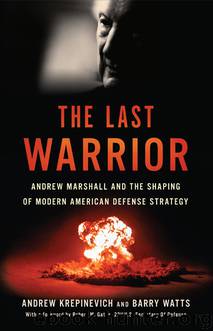The Last Warrior by Andrew F. Krepinevich

Author:Andrew F. Krepinevich [Krepinevich, Andrew; D. Watts, Barry; M. Gates, Robert]
Language: eng
Format: epub
ISBN: 9780465080717
Publisher: Basic Books
The US-Soviet strategic nuclear balance was perhaps the preeminent Cold War assessment because, in the event that deterrence failed, the survival of the United States would be at stake. The European balance was in many respects of comparable importance because of the prospect that a successful Warsaw Pact conventional attack could escalate to a general nuclear exchange. Detailed versions of both these assessments were completed in the late 1970s. But as important as these two balances were, Marshall came to view other assessments completed during Harold Brown’s tenure as defense secretary as having been even more successful. One of these was Navy commander Gerald Dunne’s assessment of US and Soviet command, control, and communications (C3), which was finished in 1978. This assessment revealed a major asymmetry, if not a gaping lacuna, between US and Soviet preparations for conflict, especially in Europe. For the Soviets, C3 loomed large. They had singled out C3 as a specialized, high-priority “area of warfare” and had developed doctrine, planning processes, tactics, and systems aimed at disrupting or destroying 50 percent of NATO’s C3 at every echelon from the theater down to battalions, while investing far more heavily in protecting their own C3 than did NATO forces.78 By contrast, the US military had a fragmented view of C3. Even more troubling, the Pentagon also lacked the concepts, frames of reference, and tools to evaluate C3 performance in combat.79
Marshall and Dunne saw the 1978 C3 assessment as highlighting an area of weakness that the US military needed to address. But the Pentagon’s senior military leaders did not react as Marshall would have liked. In the short term the assessment provoked a surge of research into C3 (including five Defense Science Board studies), increased efforts to improve the survivability of US C3, and stimulated thinking about the importance of an “information advantage” in war.80 In the long run, though, these various studies and research bore little fruit.
Today, over thirty years since ONA’s US-Soviet C3 assessment, the US military’s thinking about C3 still remains largely focused on tactical-level technical issues, giving short shrift to the overall role of information in future warfare. Marshall remains concerned that the US military still lacks the concepts, frames of reference, and tools to evaluate properly the performance of C3 and intelligence, surveillance and reconnaissance (ISR) systems in combat. These concerns have resurfaced with China’s growing efforts since the mid-1990s to modernize its military forces. One could argue that Soviet forces during the Cold War were more reflective of the industrial age than of today’s information age. China’s ongoing modernization efforts, by contrast, are unquestionably those of a rising power in the information age. The overarching goal of the People’s Liberation Army (PLA) is to build an “informationized military” with Chinese characteristics. How successful the PLA will ultimately be in this endeavor remains to be seen. But since the late 1970s Marshall persistantly highlighted the growing importance of information in future warfare.
Download
This site does not store any files on its server. We only index and link to content provided by other sites. Please contact the content providers to delete copyright contents if any and email us, we'll remove relevant links or contents immediately.
| Africa | Americas |
| Arctic & Antarctica | Asia |
| Australia & Oceania | Europe |
| Middle East | Russia |
| United States | World |
| Ancient Civilizations | Military |
| Historical Study & Educational Resources |
Cat's cradle by Kurt Vonnegut(15129)
Pimp by Iceberg Slim(14275)
4 3 2 1: A Novel by Paul Auster(12247)
Underground: A Human History of the Worlds Beneath Our Feet by Will Hunt(11992)
The Radium Girls by Kate Moore(11888)
Wiseguy by Nicholas Pileggi(5627)
Perfect Rhythm by Jae(5297)
American History Stories, Volume III (Yesterday's Classics) by Pratt Mara L(5234)
The Fire Next Time by James Baldwin(5217)
Paper Towns by Green John(5057)
Pale Blue Dot by Carl Sagan(4880)
A Higher Loyalty: Truth, Lies, and Leadership by James Comey(4817)
The Mayflower and the Pilgrims' New World by Nathaniel Philbrick(4393)
The Doomsday Machine by Daniel Ellsberg(4388)
Killers of the Flower Moon: The Osage Murders and the Birth of the FBI by David Grann(4363)
The Sympathizer by Viet Thanh Nguyen(4279)
Too Much and Not the Mood by Durga Chew-Bose(4247)
The Borden Murders by Sarah Miller(4211)
Sticky Fingers by Joe Hagan(4080)
